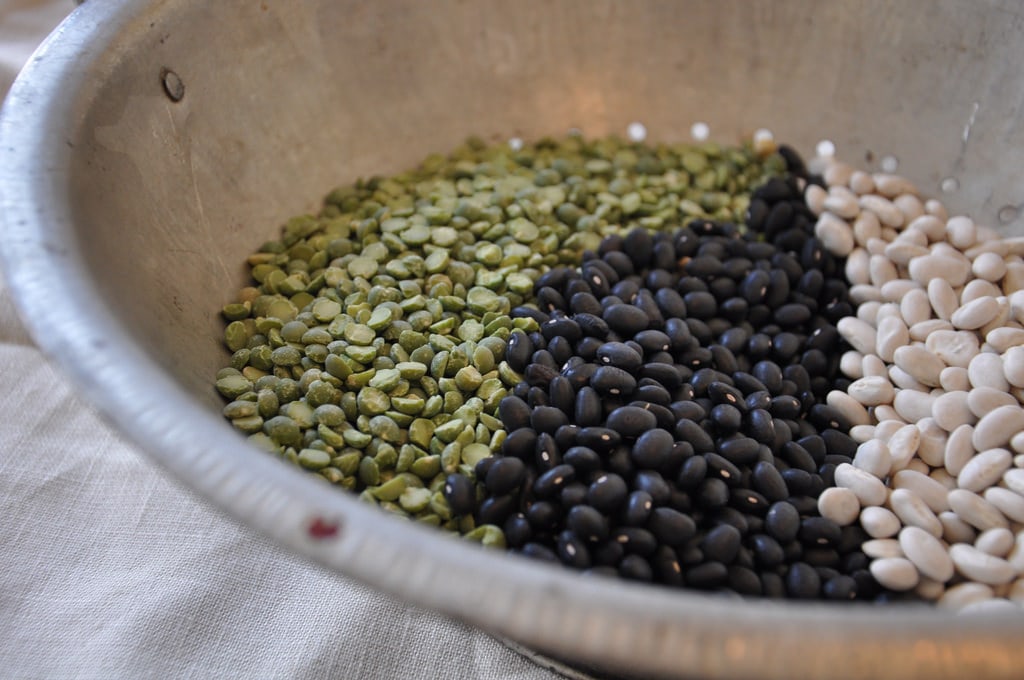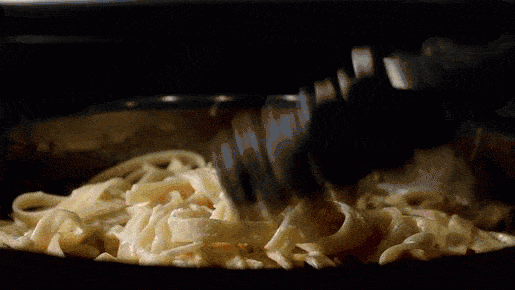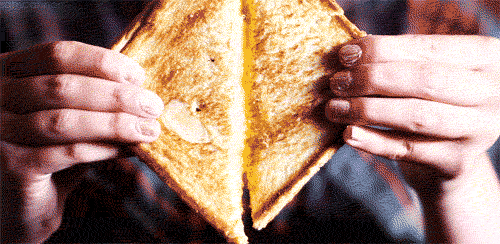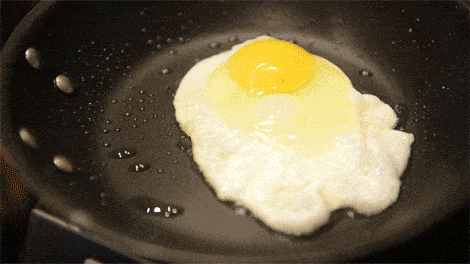
Summer is sort of a food free-for-all for the husdude and me. We cook more, we try more recipes, we pick up a crazy amount of seasonal fruits and veggies from the farmer’s market, we grill – but come fall, when the farmer’s market closes and we can’t find decent heirloom tomatoes at the grocery store, we have this jarring come-to-center moment of…what do we eat now?
During the fall and winter months, when we tend to be busier and there’s less seasonal produce available, having a well-stocked pantry can be the difference between ordering takeout over and over and having simple, nutritious weeknight meals that you know like the back of your hand.
The following list follows the basic food staples that I always keep around (not just in the pantry), plus recipes that make use of those staples.
Keep in mind that your list of must-have staples might look different from mine. If you’re vegan, you’re obviously not wanting eggs and dairy. If you’re allergic to nuts, maybe swap those out for canned or frozen fish. If you eat a ton of miso soup, miso might be one of your staples! You know what you like and don’t like better than anyone else, so feel free to make these your own.
Table of Contents
Beans

Beans, lentils, and other legumes – whether they’re canned or dried – are super cheap and an excellent source of protein, iron, and fiber. There are about a bajillion ways to eat beans, from tacos and bean burgers to soups and curries, so you can go crazy with a fire black bean enchilada recipe or keep it simple with beans and rice.
- Black Bean and Avocado Enchiladas from Budget Bytes
- Moroccan Red Lentil Soup from Feed Me Phoebe
- Cuban Black Beans and Rice from Chew Out Loud
Canned Tomatoes
It seems like I can’t sneeze without hitting a recipe that requires canned tomatoes. Sauces, soups, and curries all generally call for fresh or canned tomatoes, so having a couple of different varieties on hand – like diced, whole peeled, crushed, roasted, etc – will ensure you’ll always have a healthy meal you can make. This is also a super easy way to incorporate some veggies into a meal when your fridge is looking a little bare.
- Martha Stewart’s Indian-Spiced Bean and Tomato Soup
- Winter Lentil Vegetable Soup from Allrecipes
- Alton Brown’s Pantry Friendly Tomato Sauce
Pasta

Yeah, if you don’t like pasta, you’re not going to like eating at my house. (Also, who hurt you?) Pasta is the perfect vehicle for all the sauces you’re making with your canned tomatoes and can help bulk up watery soups, or is just great on its own with a little butter, pepper, and parm. (Cacio e pepe, friends! It’s a game changer.) So stock up on a couple of varieties – spaghetti and penne are classic choices, but I prefer linguine, orecchiette, and farfalle for ~fanciness~ reasons.
- Spicy Eggplant Pasta from Food 52
- Portobello and Leek Carbonara from How Sweet It Is
- Cacio e pepe from Bon Appetit
Rice (and other grains)

Rice and grains are full of fiber and are perfect for bulking up salads and soups, serving alongside curries, or frying into a delicious bowl of fried rice. Jasmine and brown rice are obvious choices here, but other grains like quinoa, farro, or barley are also excellent if you’re into variety.
- Chickpea, Spinach, and Sweet Potato Bowl from Green Evi
- Kimchi Fried Rice from Food.com
- Blueberry Farro Yogurt from Running to the Kitchen
Onion
You’re more likely to find recipes with onions than without, so store a few in a cabinet in a punctured bag – they’ll keep for a while and I promise you’ll never run out of ways to use them. Onions are often the base for soups, sauces, and curries, and when caramelized or pickled, they’re a great addition to easy weeknight staples like burgers or grilled cheese.
- All of the Alliums Fried Rice from Food & Wine and Molly Yeh
- Caramelized Onion, Mushroom, and Swiss Melt from Table for Two
- Lazy Sunday Casserole from Kayotic Kitchen
Frozen vegetables
Lots of the recipes featured here are great vehicles for using up leftover veggies, but when you’re on the last legs of your latest grocery shop and you’re not in the mood for leftovers, or you’re holding out on a shop until your next paycheck, a bag of frozen spinach or green beans may be the difference between beige food and nutritious food.
- Creamy Pesto Mac from Budget Bytes
- Slow Cooker Veggie Pot Pie from Slow Cooker Gourmet
- Easy Lentil Curry from Sprinkle With Love
Potatoes

The husdude and I love having a bag of potatoes around for spontaneous weekend morning hashes and homemade oven fries, but potatoes are also great for spur-of-the-moment soups and salads or as an accompaniment to a protein, if you keep frozen protein around. Don’t forget about sweet potatoes and purple potatoes, too!
- Kielbasa, Pepper, Onion, and Potato Hash from the Two Bite Club
- Zuppa Toscana from Budget Bytes
- Roasted Sweet Potato, Spinach, and Grain Salad from Naturally Ella
Cheese

If you’re not eating a vegan diet, having shredded cheese, goat cheese, or parm on hand is an excellent way to add a touch of creaminess and luxury to simple meal without breaking the bank. Cheese is a little more expensive, of course, so don’t go crazy, but most cheese can be frozen if you’re not certain you’re going to be able to eat it all before it expires.
- Goat Cheese Pasta With Spring Vegetables from Life As a Strawberry
- Dill Pickle Bacon Grilled Cheese from Spend With Pennies
- Kale Superfood Salad With Quinoa and Blueberries from Kristine’s Kitchen
Eggs

Like beans, eggs are fairly cheap and are a good source of protein, making them an excellent choice for vegetarian meals. Even though they don’t have as long of a shelf life as beans, they’re a staple in many quick meals like fried rice, shakshuka, and chilequiles, and a fried egg can go on top of anything from rice and beans to salads to hashes to pastas.
- Chilaquiles from Spoon Fork Bacon
- Shakshuka With Swiss Chard from Food & Wine
- Egg Drop Soup from She Wears Many Hats
Nuts and Seeds
Nuts and seeds are a little more expensive than beans, but they’re a great vegan source of protein and fat, so keep a couple of varieties in your pantry if you can afford to. Sprinkle them on salads, soups, and stir fries, blend them into pesto, make breakfast bars with them – girl, you’ve got options.
- Homemade Basil Pesto from Little Spice Jar
- Quinoa Mango Black Bean Salad With Smoky Pepitas from Vanilla and Bean
- Quinoa Granola Bars from Honestly Yum
What do you think?
What are your pantry staples? Will you try any of these recipes? What are your go-tos? Let me know in the comments below!

Definatly second the frozen vegetables. They are often more practical than fresh as they last alot longer and it is also easier and cheaper to get frozen veges when those particular veges are out of season.
Great post!! So many good veggie options! Thanks! I’ve bookmarked a bunch of these on pinterest :^)